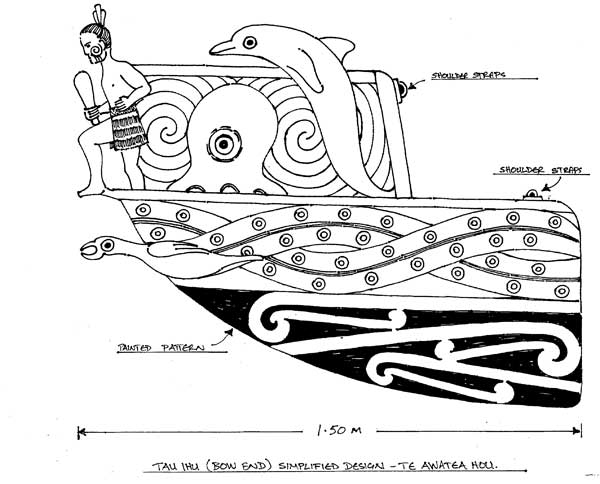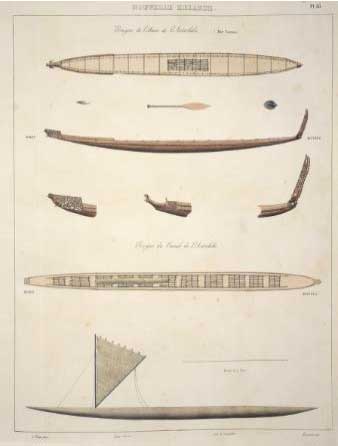Te Tau Ihu o Te Waka a Aoraki
The name, Te Tau Ihu o Te Waka, stems from creation myths of earliest Polynesian inhabitants of Aotearoa (New Zealand)
The ancient name of the South Island was Te Waka a Aoraki, a name given by the early Polynesian inhabitants of Aotearoa. Te Tau Ihu o Te Waka a Aoraki is therefore an alterative name for the Top of the South Island - Te Tau Ihu o Te Waka a Māui is now more widely used.
The gods, Aoraki and his three brothers (begat by Ranginui-e-tu-nei and his first wife Poharua Te Po), were half brothers of Tāne, Tangaroa, Kiwa, Tāwhirimātea and their seventy brothers (offspring of Ranginui’s second marriage to Papatūānuku). These brothers were born into a state of never-ending nothingness, trapped between the bodies of their parents who were eternally united in their undying love. Tiring of this unchanging existence, under Tāne’s leadership, the brothers succeeded in forcing their parents apart. Tāne and most of his brothers remained with their mother; Tāwhirimātea became his father’s ally, as god of storms and tempests, while Rūamoko was trapped within his mother’s body.
The energies released in the violence of their separation created the universe: heaven, earth, seasons, and the diurnal cycle. Ranginui became Sky Father and Papatūānuku became Earth Mother, separated for all eternity. Rangi’s tears fall on his beloved Papatūānuku as rain, while Papa’s tears rise to Rangi as mist.
Tāne and his brothers began beautifying Papatūānuku by sculpting her features and populating her domains, but were constantly beset by storms whipped up by angry Tāwhirimātea. Rūaumoko, incensed at being trapped in his mother’s vast body, vented his anger by causing upheavals in the earth’s crust to destroy his brothers’ works.
Aoraki and his brothers later descended from heaven, curious to meet their half-brothers. While they explored the southern ocean, Tāwhirimātea sent a devastating storm, capsizing their waka. Aoraki, his brothers and crew, scrambled onto the side of their overturned canoe to avoid being flung into the maelstrom. The storm’s violence turned everything to stone - the waka, the crew and their cargo - so creating the South Island, or Te Waka a Aoraki. The crew became the Southern Alps, with Aoraki petrified as the highest peak, Aoraki - Mount Cook, surrounded by his brothers as neighbouring peaks.
Nga whakairo ātaahua (beautiful carvings) of the taurapa (sternpost) of Aoraki’s waka became Fiordland, while the ornate tau ihu (the prow) formed Farewell Spit, Golden Bay, Tasman Bay and the islands and coves of the Marlborough Sounds and Cloudy Bay. This was Te Tau Ihu o Te Waka a Aoraki – The Prow of the Canoe of Aoraki.
Over millennia, the sons of Ranginui and Papatūānuku continued to adorn their mother. Tangaroa stocked the oceans, Tāne populated her lands with flora, fauna and humankind, Rūaumoko created new landforms, and their artistic brother, Tū-te-Rakiwhanoa, further beautified Papatūānuku by sculpting the main coastal features of Te Waka a Aoraki. But, on arriving in Te Tau Ihu, Tū-te-Rakiwhanoa rested, as not even his creative talents could enhance the elegant original carvings of Te Tau Ihu o Te Waka a Aoraki. The beauty of our region has been recognised since earliest times!
Other ancient traditions attribute the name, Te Tau Ihu, to Māui-Tikitiki-a-Taranga, the demi-god who, from the South Island (Te Waka a Māui), fished up the North Island (Te Ika a Māui – the fish of Māui). Some say that it was on Arapaoa Island, a prominent feature of the prow of his canoe, that Māui stood to land his sacred fish.
2008
Updated April 2020
Story by: Hilary and John Mitchell
Sources
- Mitchell, H & J (2004) Te Tau Ihu o Te Waka: A History of Maori of Nelson and Marlborough Vol I The People and the Land, pp18-21, and the references cited there.
http://www.worldcat.org/oclc/63170610
Further Sources
Books
- Beattie, J.H (1949) The Maoris and Fiordland Dunedin : Otago Daily times & Witness, pp.7-13 http://www.worldcat.org/oclc/9033334
- Cowan, J. (1910) The Maoris of New Zealand. Christchurch, N.Z., London, Whitcombe and Tombs, p.57
http://www.worldcat.org/oclc/3000613 - White, J (1887,1888) Ancient History of the Maori..Wellington: Government Printer. vol 3, p. 116.
http://www.worldcat.org/oclc/6497007/editions?editionsView=true&referer=di and full-text
http://www.nzetc.org/tm/scholarly/tei-corpus-WhiAnci.html
Newspapers
- Best, E. (1918) The land of Tara, Journal of the Polynesian Society, 27(105)
http://www.jps.auckland.ac.nz/document/?wid=1386 - Best, E. (1907)Transactions of the New Zealand Institute, vol XL, p. 188
- Pakauwera, E.W. & Smith, J (translator) (1917) Notes of the Ngati Kuia tribe of New Zealand, Journal of the Polynesian Society, 26, pp.116-129
http://www.jps.auckland.ac.nz/document/?wid=891 - Smith JPS (1894) Geneaology of the Te Mamaru family of Moeraki, Northern Otago, New Zealand, Journal of the Polynesian Society , 3 1894, p. 13.
http://www.jps.auckland.ac.nz/document/?wid=190
Websites
- Mitchell H&J (2008). Te Tau Ihu tribes. Retrieved from Te Ara - the Encyclopedia of New Zealand:
http://www.teara.govt.nz/en/te-tau-ihu-tribes - Pou Pou carvings (ancestors of the South Island and Nelson). Retrieved from Nelson City Council, 10 February 2010
http://www.nelson.govt.nz/assets/Our-council/Downloads/pou-pou-history.pdf - Te Ahukaramu Charles Royal (2008). Māori creation traditions. Retrieved from, Te Ara - the Encyclopedia of New Zealand:
http://www.teara.govt.nz/en/maori-creation-traditions

